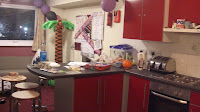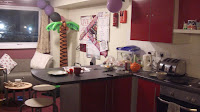How old are you?
Twenty.
What images keep you company in the space where you work?
In the flat; photos of family and friends, art books/sketchbooks, Arctic monkeys poster, club nights and university advertisements, inspiration for work.
At my family home; family and friend photos, my own previous work, CDs and DVDs, gig and theatre tickets, television, two radios.
At my family home; family and friend photos, my own previous work, CDs and DVDs, gig and theatre tickets, television, two radios.
What was the first piece of art that really mattered to you?
Roy Lichtenstein - Whaam!, Leonid Afremov - Today I Forgot My Umbrella, and Giambologna's marble 'Statue Hercules Killing the Centaur' in Florence.
Roy Lichtenstein - Whaam!, Leonid Afremov - Today I Forgot My Umbrella, and Giambologna's marble 'Statue Hercules Killing the Centaur' in Florence.
What is your favourite title of an artwork?
'An Oak Tree'.
What do you wish you knew?
What is art? What I want to do in life? My grand parents. Freize's answer 'The answers to the questions I don't have the answers to.'
What's your favourite journeys?
Pulling into Liverpool Street Station. Anywhere by plane. Late night car journeys to the airport. Train journey into Edinburgh. London Euston to Birmingham New Street. The road less taken. Home.
What should change?
Rudeness. People giving me disapproving looks when I say I'm taking a degree in Art. People giving me disapproving looks when I say I'm taking a degree at BCU. Ungrateful people. The weather.
What should stay the same?
My Life. My family. My friends. Unexpected acts of kindness. University fees.
What could you imagine doing if you didn't do what you do?
Training to be a maths teacher. Travel the world. Interior Designer.
Training to be a maths teacher. Travel the world. Interior Designer.
what music are you listening to?
Arctic Monkeys. The Vaccines. Friendly Fires. Radio 1. Metronomy. Lena Del Ray.
What are you reading?
Frieze magazine. ID. Elle. Art in Theory. Lecture notes. Everything by Nick Hornby.
What do you like the look of?
City skylines - day and night. Natural landscapes on a clear day. Graphic novels. Clothes that I want. My room when tidied. Finished work. The BCU logo. Rain on a car/train window. Looking down on clouds. Tacky Christmas jumpers.

















































